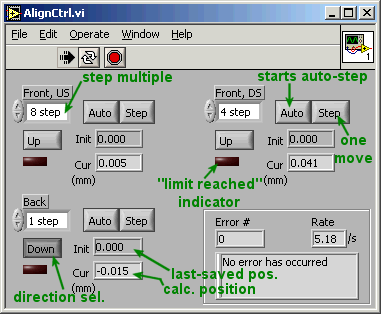Microscope Prototype Beam Test
The purpose of this note is to gather all the information pertinent to the beam test of the tagger microscope prototype in Hall B planned for the fall of 2010.
Contents
Introduction
- Proposal: Beam test plan
- Concise list of resources: Spring 2011 Hall B beam test: installation and running
Schedule
- JLab visit dates by UConn group:
- Oct 8-15, 2010 (personnel: Richard J., Igor S.) Goals:
- instrumentation staging - testing of DAQ with microscope out of the Hall (on the bench)
- March 8-11, 2011. Critical dates: Hall B open Feb 25th to March 28th. Hall B tagger calibration March 26-28th.
- Oct 8-15, 2010 (personnel: Richard J., Igor S.) Goals:
Setup
Network Configuration for clonwin3
The following static configuration came with clonwin3, borrowed from Hall B
Connection-specific DNS Suffix . : jlab.org
Description . . . . . . . . . . . : Intel(R) PRO/100 M Network
Physical Address. . . . . . . . . : 00-07-E9-EF-EB-8C
Dhcp Enabled. . . . . . . . . . . : No
IP Address. . . . . . . . . . . . : 129.57.167.20
Subnet Mask . . . . . . . . . . . : 255.255.255.0
Default Gateway . . . . . . . . . : 129.57.167.99
DNS Servers . . . . . . . . . . . : 129.57.167.5
129.57.32.100
Primary WINS Server . . . . . . . : 129.57.32.121
Secondary WINS Server . . . . . . : 129.57.32.126
Counter positioning
- Hall B Tagger Montecarlo
- Source [link TBA]
- Results [TBA]
- Selected position: [info TBA]
- Coordinates:
- Position instructions:
- x-axis: the line marked on the sides of the foil window indicates the 0±2mm position of the scintillating fibers. (±8mm motion is possible)
- Discriminator selection/positioning instructions:
The scintillating fiber position and tilt inside the Microscope enclosure is controlled with a GUI shown on the right. Links to it have been made on the operator user desktop or can be found among the Microscope tools in E:\Tagger. The three-point controls of the plane that defines he scintillator array position are labeled based on their location with respect to the electron beamline: upstream (US), downstream (DS) and back, the last being further away from the beamline whereas the first two are right under the scintillators.
The program has been calibrated to the mechanics of the actuated mount and reset to what should be proper zero position. A recording of the calculated support point heights is made in AlignPos.ini in the same directory as the AlignCtrl executable. The GUI loads the last position when starting up. Based on these records, the program ensures that the height of any support never exceeds what is allowed by the mechanics: ±8mm of middle. The program will not allow stepping beyond these bounds and will flash the red indicator for offended mount point. Always make sure the motor system is powered before running this GUI and never turn a motor shaft by hand - this will ruin the calibration.
Control/Monitoring of microscope electronics
Very simple, PCap-based, Windows console tools have been made for debugging and beam-testing: PktMon for monitoring Ethernet packets from the Control Board and PktSend to issue commands. Sub-directories for these are in the Cygwin home path for user operator
PktMon
PktMon is a Windows command prompt application. (there are issues with output in Cygwin)
- PktMon.exe asks you to choose an interface to monitor for Microscope response packets and formats the incoming data in an ineligible way. Optional arguments:
- -s [device name] bypasses the device selection at run time
- -s [device name] [output_file] bypasses the device selection at run time and logs the incoming packet information in the specified file.
- StartPktLog.bat is a wrapper for PktMon that specifies the device appropriate for the machine and can optionally take the output file as an argument
- "Log Packets" link on the desktop calls StartPktLog.bat pktdump.txt, i.e. starts logging to pktdump.txt
- "Monitor Packets" link on the desktop just calls StartPktLog.bat to show the incoming responses from the Microscope on the screen
PktSend
PktSend consists of an executable sendpack.exe that formats a command packet to the Microscope based on the hexadecimal values specified in the arguments. It is not intended to be used directly. A wrapper Ruby script PktSend.rb has various options that can be listed with the -h argument. Basic usage:
PktSend.rb -q
sends a query request to the Control Board which responds with a "status" packet, listing nine various parameters.
PktSend.rb -f [config_file]
sends a programming packet based on the voltages specified in the configuration file, which is itself a Ruby script. Vbias.rb is included as a configuration file whose values can be edited as necessary.
Less commonly used options: -r and -e request "hard" and "soft" resets respectively. A soft reset command should follow a hard one. Soft reset clears voltage setting registers and teaches the Control Board that the computer originating the command is the master. (Before this point in the start-up sequence, packets were sent my the Microscope via broadcast. Now, packets are directed to the commuter that issued the soft reset.)
DAQ setup
Configuration
Connection/Operation instructions
- interface?
- remote connection?
